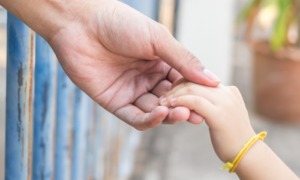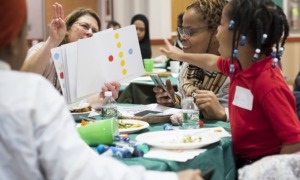
NEW YORK — Demetrius Johnson was placed into foster care when he was only a few months old. Over the course of the next 17 years, he was shuffled between more than 25 foster homes. Some of his foster placements were abusive; others failed due to his behavior.
“I felt that if not only my parents, they could get rid of me, and then the lady who adopted me, she could get rid of me, that anybody that came into contact with me could get rid of me,” said Johnson, 18, from bench in a new park filled with overly-safe plastic equipment near the hulking Barclays Center. “So I used to test foster parents.”
The struggles Johnson faced are all too common for youth in foster care. Fewer than half leave foster care with a high school diploma. They are also more likely as adults to be unemployed, incarcerated or homeless.
Author Cris Beam tries to get to the root causes of these troubling statistics in her new book, “To The End of June: The Intimate Life of American Foster Care.” Beam, a foster parent herself, spent five years researching the book, which focuses primarily on New York City’s child welfare system.
Through conversations with foster parents, biological parents, policy experts and, most importantly, the youth themselves, Beam takes us inside a system that impacts the lives of tens of thousands of New Yorkers everyday, but goes largely unnoticed by the rest of the public.
“I really felt the push to write this because I felt it affecting my life all of the time,” Beam said. “I saw all of these kids with so much suffering, but I never heard people talking about it. I’ve never heard it addressed in a presidential platform or even really in local elections. It’s almost like it’s invisible.”
Much of the book revolves around Bruce and Allyson Green, a couple who take in eight foster children, mostly teenagers. They live in a sprawling house in Brooklyn and Beam describes how they approach their role as foster parents with firm hands and soft hearts. They enforce the same strict rules for both their biological and foster children. They also perform many small kindnesses, such as hanging up each child’s portrait so they all feel welcome.
At first this mixture of structure and kindness seems like a magic elixir. One foster daughter, Tonya, gets her temper under control and her grades up. Another, Fatimah, forms close bonds with her foster sisters. Even Dominique, a girl Beam describes as “wearing the hard face of rebellion” when she first arrives, warms up to her new surroundings.
And then, things begin to unravel.
The agency calls to say that the Greens don’t have the specialized training they need to foster Dominique. She will have to be placed with a new family. The Greens volunteer to do more training, but the agency can’t or won’t budge. In a last ditch attempt to hold onto Dominique, the Greens offer to adopt her.
At first everyone is thrilled, but as the adoption date draws nearer, Dominique has second thoughts. Her ambivalence leads to a falling out with the Greens and she is moved to yet another foster home.
Beam says that it’s common for foster children to struggle with this decision.
“Adoption may be the explicit goal for foster kids with parents who have lost their rights, but it can also be a trigger,” she writes. “’This is it’, adoption says. ‘You can never go home again.’”
The system isn’t built to account for the time it may take to work through such conflicting emotions. Laws such as the federal Adoption and Safe Families Act set strict time lines. Under ASFA, social workers have 15 months to decide whether to return a child to his biological home or terminate parental rights and find an adoptive family.
The law is intended to prevent foster children from drifting in a kind of bureaucratic purgatory. However, it can cut ties to family and force the adoption issue too soon. If a foster placement is working, critics wonder, why not allow the child and family to talk about adoption when they are ready?
Dominique’s story also touches on another theme of the book: the way that bureaucracy may interfere with doing what’s best for a child. Beam talks to case workers who complain about the endless funding paperwork that takes away from time they’d rather spend with their clients. She talks to teens who have been removed from good foster placements because the homes lacked the required square footage.
In one of the more frustrating examples of this nitpicking, if a child leaves a good foster home to return to a biological parent, it is very unlikely that she will go back to that home in the event she returns to care. Instead, she will be given the first available placement. The foster parent is rarely told that the child has re-entered the system.
By the end of the book, the Greens’ carefully calibrated home has fallen into disarray. Adoptions fail; children run away; the agency has to intervene. The Greens are disillusioned and disappointed the agency did not provide them with more help.
“I used to think that any child that came to us we could help,” Bruce Green said. “We won’t be taking any more teenagers. They already have too much damage.”
Beam agrees that many foster parents are woefully unprepared for the challenges they will face and need more formal support.
“What’s being said is: ‘If this kid isn’t working for you, we’ll get you a different kid, a better kid, a more convenient kid,’” she said. “Foster parents need to be supported in a way, like, whatever it takes to keep this kid in the home.”
Through the Greens’ story, Beam zeroes in on the problems that plague the child welfare system and that can confound even the best-intentioned foster parents. And yet, she sees glimpses of hope.
































